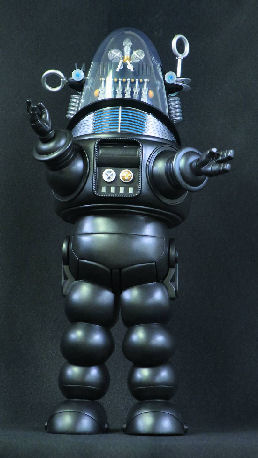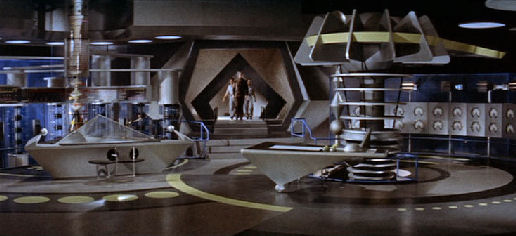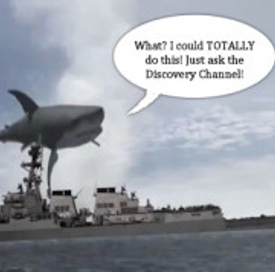It seems to me that some of us who’ve been around a while in the SF/F field take a lot of things for granted: the “big names” of the field; the “must-read” books that everyone’s read; the “must-see” movies that everyone’s seen and so forth. But is that entirely true? Like everything else, our field is evolving quickly, and what was true twenty—or even ten—years ago might not be true today. I’ve recently found that a few friends haven’t seen some of the true classics of the field. Among them is one of the first big-budget, big-screen (and, where Walter Pidgeon was concerned, big name) SF films.

In 1956, when I was 9 years old, my mother bought—at my urging—a big cylindrical container of Quaker Oats; that was how they came in those days, instead of a rectangular box. Because in spite of the fact that I hated oatmeal with a passion—it’s gluey and bland, unless you add stuff to it, like brown sugar and/or fruit (and as you can probably tell, am not too fond of it today)—I’d found out somewhere that each specially-marked package contained a free movie ticket to go see the new SF movie, Forbidden Planet! And so she did, and I did open the box and dig down into all that oatmeal—and found my ticket. And do you know what happened next? NOTHING! I could not persuade my parents to let me go to the movie alone, nor was either one of them interested in seeing the show. And so it was many years later that I finally saw it on TV. As you can guess, it was scanned, panned and chopped to bits. (Kind of like what happens to a really cool movie poster—Figure 1—when it’s reduced to 258 pixels wide.)
It again was years later that I saw the movie in its original aspect ratio, uncut and shown the way it was supposed to be seen in the theatre, and it has always held a special place in my heart. It was one of the first-ever “big budget” SF movies to be made, eventually costing MGM almost two million dollars—probably ten times that much in today’s money, according to the CPI inflation calculator. But since box office receipts were only about three million, the studio barely broke even. Even so, this movie paved the way for future big-budget SF movies. (By the way, even though the song Science Fiction Double Feature from Rocky Horror Picture Show claims that “Anne Francis stars in Forbidden Planet, the actual star of the picture was Walter Pidgeon. Anne did, however, get second-billing.)
If you know much about the movie, you’ll know that it was very loosely based on The Tempest by William Shakespeare. In Shakespeare, we have the magician Prospero, who will be subbed by Walter Pidgeon’s Dr. Morbius; his daughter Miranda, who becomes Altaira, played fetchingly by Anne Francis; the sprite Ariel becomes a rather clunky robot named Robbie, voiced by Marvin Miller; the monster Caliban morphs into an invisible “monster from the id” (played as a Disney animation); and finally, Ferdinand the duke’s son—who falls for Miranda at first sight and she him—is played (straight) by Leslie Nielson as Commander Adams.

In screenwriter Cyril Hume’s version of The Tempest, we find that “in the last decade of the 21st century, mankind landed on the moon using chemical rockets, then discovered hyperdrive by 2200, which enabled them to … exceed the speed of light by many times”—and then we started exploring, colonizing and “conquering outer space.” One of the colonies that disappeared was the colony that, using the spaceship Bellerophon, went to the fourth planet of the Altair system around twenty years ago; the starship C57D is sent to find them. (By the way, even though this movie is almost sixty years old, I shall attempt to do this column without too many spoilers. Just in case you haven’t seen it.)
The starship C57D breaks out of hyperspeed fairly close to the star Altair; as the ship creates a beautifully animated sequence to put a planet between them and the sun, one crewmember remarks that at least this ship can “create its own eclipse.” For a movie that’s almost fifty years old, some of the effects are very contemporary. (In my opinion, the sole exception is Joshua Meadors’ (on loan from Disney) animations of the guns’ lasers, the “monster” effects and a couple of others. Although there’s a certain retro charm to these effects, they are very dated in today’s CGI world. (By the way, one of the matte painters—uncredited, according to IMDB—was Matthew Yuricich, the brother of Richard Yuricich; both brothers between them did matte paintings for most of the modern classics of SF, including Close Encounters of the Third Kind, Star Trek: The Motion Picture, and on and on.)
The C57D—unlike the Star Trek Enterprise—wasn’t given another name; however, its design is very familiar to us now. It appears to be based on the classic “flying saucer” design—remember that when this movie was released, the first flying saucer report had been made only nine years before! By 1956, the flying saucer had been seen in all kinds of publications—Alex Schomburg’s slick airbrush paintings of saucers had graced all kinds of SF magazines as well as a couple of Winston YA books. The beautiful C57D (does that number sound at all familiar?) was represented by three different-sized lighted models: one at twenty inches, one at forty-four inches, and a giant one at eighty-eight inches! According to one source, the C57D dropped out of light speed at 17:01 hours, thus providing a familiar number to another well-known spaceship. Also, the “DC,” or deceleration tubes, with their green glow, were probably the inspiration for Star Trek’s transporter beams. (I also think the saucer in the opening credits of John Carpenter’s The Thing was an homage to this design. Another stunning effects sequence, by the way, that did not depend on CGI.)
Anyway, upon scanning the planet’s surface for any trace of the Bellerophon or its colonists, the C57D’s crew is surprised to be hailed via radio from the surface; an area of about 20 square miles appears to be the only man-made improvements on the whole planet. A voice identifying itself as Dr. Edward Morbius, the philologist of the Bellerophon’s colonists, begs them not to land; and tells them that if they ignore his advice to turn back to Earth immediately, he can “not be held responsible for whatever happens to them.” Of course, they ignore his advice and he provides landing coordinates. Notice the green sky; the blue water is moving in the swimming pool.

They are met by an odd vehicle coming across the wastes at a very high speed; however, the car, if that’s what it is, doesn’t appear to have a driver. When it arrives, the “driver” steps out as if he had been part of the vehicle—and we meet Robby the Robot. Now, many of you (and I know, ‘cause I’ve had a number of conversations over the years about this) believe that Robby is the same robot that was in the TV series Lost in Space. No, he’s not. Although he made at least one appearance on that series, the Lost in Space robot was actually called the B-9, I believe. They were designed by the same person, Robert Kinoshita, who called B-9 “Blinky,” and who also designed the Jupiter 2 spaceship for that series—my guess is he partially based the Jupiter 2’s design on the C57D. (I had to cheat for the Robby picture; I couldn’t find a really good full-figure one. So this is a 12-inch model.)

Robby takes Captain Adams and his command crew, Lieutenant “Doc” Ostrow (Warren Stevens) and Lt. Farman (Jack Kelly) to Morbius’s home, where they meet Morbius and his daughter Altaira (Anne Francis), “Alta” for short. There they find out the fate of the crew and colonists of the Bellerophon, who were killed by something unknown—a “force” that Morbius and his wife were strangely immune to. Morbius explains that he and his wife had come to love Altair IV as their home, while the rest of the colonists and crew were planning to leave for Earth; maybe that was the reason they were spared. His wife, unfortunately, died shortly after Alta’s birth—from natural causes.
A note here about the performers: Walter Pidgeon was well known as a “serious” actor, having achieved fame and an Oscar nomination for such films as Mrs. Miniver, How Green Was My Valley and so on. Anne Francis appeared in bit parts in several films as well as a number of TV appearances in such shows as Kraft Theatre and Lux Video Theatre, but was by no means a name, or headline actress. Her star turns on television as Honey West and Cathy Gale in The Avengers (she was the female lead before Diana Rigg’s Mrs. Peel) were yet to come. Leslie Nielsen was also a “serious” actor, and had gained a solid reputation on television in such shows as Kraft Theatre, Danger!, Studio One and quite a few others. His days as a funnyman were years in the future. Jack Kelly seemed to gravitate to Western roles, although he was by no means limited to them. His years as Bart Maverick—Bret’s (James Garner) brother in the popular series Maverick—were still to to come. Warren Stevens had done small movie roles and a number of TV roles. He never got his own series, but had recurring roles on several well-known shows, like Mission Impossible, Ironside, Hawaiian Eye and Combat! Richard Anderson, who played Chief Quinn, had done mostly small movie parts; he later became well known as Oscar Goldman on the TV series The Six Million Dollar Man. The cook’s part, played for comic relief by Earl Holliman, gave no clue that he would achieve some TV fame as Angie Dickinson’s sidekick on Police Woman many years later. Holliman, like all the others named, has had a long and varied career. Oh, and Robbie was voiced by Marvin Miller, who would go on to be on TV’s The Millionaire, giving a million dollars a week away for the reclusive John Beresford Tipton (Paul Frees, a terrific impersonator and voice actor).

It appears that the C57D couldn’t leave even if they wanted to—which they didn’t; there were still too many unanswered questions about the Bellerophon—and because somehow, during the night, even though a watch was being kept, someone broke into the ship and destroyed a vital piece of equipment. On another note, the ship’s officers—notably Jack Kelly’s Lt. Farman—were introducing Alta, who’d never seen another human than her father, to the joys of kissing. Later, she and Commander Adams gravitate towards each other. Things ensue, people are killed, and Adams and his officers find out that Morbius has been holding information back—the planet had, 200,000 years in the past, been home to a “super race” called the Krell, who had, in a million years of evolution, become nearly the perfect beings. Morbius introduces Adams, Farman and “Doc Ostrow to the underground works of the Krell, whose power taps go fifty miles into the planet. It appears that the Krell—whose entire library, holding more information than “a million Earth libraries” is available to Morbius and Morbius alone—may be responsible for the deaths not only of the Bellerophon and its crew, but the more recent deaths of the crew members of the C57D!
As we’re getting into “spoiler” territory, I must stop my descriptions here. I hope that, if you haven’t already seen this movie—if not on a movie screen, at least on a widescreen modern TV in DVD or Blu-Ray (my DVD dates from 2006—the fiftieth anniversary; it’s available on Blu-Ray as well. The DVD has been digitally remastered)—you’ll be spurred by my description to do so. The film was the very first movie to have a non-musical “tonality” soundtrack by Louis and Bebe Barron. Instead of the usual musical background and “cues,” we’re treated to a series of beeps and boops and other odd sounds. Often they are very fitting for the scene… but sometimes they’re just annoying.
If you feel like it, please comment on this week’s column/blog entry. If you haven’t already registered—it’s free, and just takes a moment—go ahead and register/comment here; or comment on my Facebook page, or in the several Facebook groups where I publish a link to this column. I might not agree with your comments, but they’re all welcome, and don’t feel you have to agree with me to post a comment; my opinion is, as always, my own, and doesn’t necessarily reflect the views of Amazing Stories or its owners, editors, publishers or other bloggers. See you next week!











Steve, nothing rankles like a childhood injustice — and what an injustice that was, being denied the opportunity to see Forbidden Planet when you had a free ticket.
I bet you’re right that a lot of people haven’t seen it, but every genre fan should discover it, now that widescreen TVs and DVD/BluRay have finally made it possible to appreciate the movie at home. I watched it some time ago with my kids and they enjoyed it a lot.
I love Forbidden Planet! It’s one of my favourite films! But I have never seen it in a theater!
Everybody should see Forbidden Planet! (And Destination Moon too, the earlier technicolor sci-fi blockbuster that paved the way for FB, War of the Worlds, and other future big budget sci-fi films.)
By the way, Quaker Oats still comes in cylindrical containers – and it’s still bland 😉